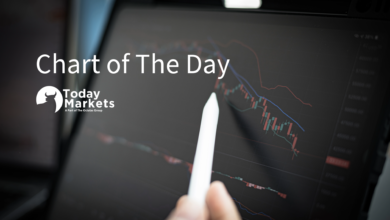UK CPI set for a slight decline in March, reinforcing BoE easing expectations
- The United Kingdom’s Office for National Statistics will publish the March CPI data on Wednesday.
- The annual UK headline inflation is set to cool in March, while core CPI is seen to remain unchanged.
- The UK CPI data could inject volatility around the Pound Sterling amid a cautious BoE.
The United Kingdom’s (UK) Consumer Price Index (CPI) data for March will be published by the Office for National Statistics (ONS) on Wednesday at 06:00 GMT.
The UK CPI inflation report could significantly impact the market’s expectations for the Bank of England’s (BoE) future interest rate cuts, which could trigger a big reaction in the Pound Sterling (GBP).
What to expect from the next UK inflation report?
The UK Consumer Price Index is forecast to rise 2.7% year-over-year (YoY) in March, following a 2.8% increase in February.
The reading is expected to remain distant from the BoE’s 2.0% target.
Core CPI inflation, which excludes energy, food, alcohol, and tobacco prices, is expected to rise by 3.5% YoY in March, unchanged from February.
According to a Bloomberg survey of economists, official data is expected to show that service inflation has ticked lower to 4.8% in March after remaining at 5% in February.
Meanwhile, the British monthly CPI is expected to rise by 0.4% in the same period, matching the increase recorded in February.
Previewing the UK inflation data, TD Securities analysts noted: “We expect inflation to continue dropping in March, with headline coming in at 2.6% (mkt: 2.7%; prior: 2.8%). Services are the main driver at 4.7% YoY (prior: 5.0% YoY, mkt: 4.8%), which would also feed into a decline in core to 3.3% YoY (prior: 3.5% YoY). Though these numbers remain above the BoE’s comfort, the downward trajectory will be welcomed ahead of their May meeting.”
How will the UK Consumer Price Index report affect GBP/USD?
The expected slight cooldown in British inflation would clear the BoE’s path to cut rates by 25 basis points (bps) to 4.25% at its May 8 policy meeting.
Meanwhile, money markets are pricing in 75-100 bps of total rate reductions this year due to the gloomy UK economic outlook, courtesy of the global tariff war.
At its March monetary policy meeting, the BoE held interest rates at 4.5%, with the voting pattern showing 8-1 in favor of holding rates, while one member voted to cut.
The bank said in its policy statement that “global trade policy uncertainty has intensified” in recent weeks, citing US tariffs and other countries’ responses.
Therefore, an upside surprise to the headline inflation data would push back against the expectations of further rate cuts by the BoE following the potential easing in May. In such a case, the Pound Sterling will receive the much-needed boost, lifting GBP/USD closer to the 1.3300 barrier. Conversely, tamer inflation readings will likely revive bets of aggressive BoE rate cuts, which could trigger a fresh GBP/USD downtrend.
Dhwani Mehta, Asian Session Lead Analyst at FXStreet, offers a brief technical outlook for the major and explains: “GBP/USD is battling the 1.3200 barrier while holding well above all major daily Simple Moving Averages (SMA) heading into the UK CPI release. The 14-day Relative Strength Index (RSI) momentum indicator stays above 50. A Golden Cross is in the making as the 50-day SMA is on the verge of crossing the 200-day SMA from below. These technical indicators continue to paint a bullish picture for the major in the near term.”
Dhwani adds: “The pair needs acceptance above the 1.3250 psychological barrier to extend the uptrend toward the 1.3300 threshold. The next topside target is aligned at the October 2024 high of 1.3390. Conversely, the immediate support is seen at the 21-day SMA at 1.2958, below which the confluence zone of the 50-day SMA and the 200-day SMA around 1.2810 will be tested. If sellers crack that level, a fresh downside toward the 100-day SMA of 1.2652 will be inevitable.”
British Pound PRICE This month
The table below shows the percentage change of British Pound (GBP) against listed major currencies this month. British Pound was the strongest against the US Dollar.
| USD | EUR | GBP | JPY | CAD | AUD | NZD | CHF | |
|---|---|---|---|---|---|---|---|---|
| USD | -4.68% | -2.12% | -4.46% | -3.61% | -1.74% | -3.92% | -7.62% | |
| EUR | 4.68% | 2.64% | 0.21% | 1.08% | 3.03% | 0.76% | -3.13% | |
| GBP | 2.12% | -2.64% | -2.40% | -1.54% | 0.38% | -1.84% | -5.63% | |
| JPY | 4.46% | -0.21% | 2.40% | 0.89% | 2.84% | 0.54% | -3.31% | |
| CAD | 3.61% | -1.08% | 1.54% | -0.89% | 1.93% | -0.32% | -4.17% | |
| AUD | 1.74% | -3.03% | -0.38% | -2.84% | -1.93% | -2.21% | -5.99% | |
| NZD | 3.92% | -0.76% | 1.84% | -0.54% | 0.32% | 2.21% | -3.86% | |
| CHF | 7.62% | 3.13% | 5.63% | 3.31% | 4.17% | 5.99% | 3.86% |
The heat map shows percentage changes of major currencies against each other. The base currency is picked from the left column, while the quote currency is picked from the top row. For example, if you pick the British Pound from the left column and move along the horizontal line to the US Dollar, the percentage change displayed in the box will represent GBP (base)/USD (quote).





